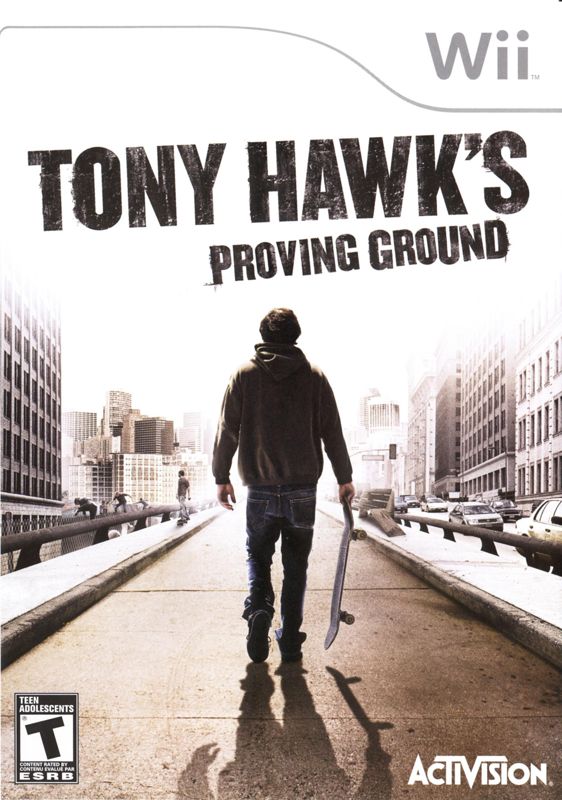Retro Replay Review
Gameplay
Tony Hawk’s Proving Ground builds on the solid foundation of its predecessor, Tony Hawk’s Project 8, by offering a more varied and player-driven approach to its core skateboarding mechanics. Right from the start, you’ll choose one of four skater classes—Rigger, Hardcore, Career, or Street—which not only affects your stats and trick focus but also steers the narrative in different directions. This branching structure gives the game a welcome replayability factor, encouraging you to try multiple career paths and see how each class unlocks unique challenges and rewards.
(HEY YOU!! We hope you enjoy! We try not to run ads. So basically, this is a very expensive hobby running this site. Please consider joining us for updates, forums, and more. Network w/ us to make some cash or friends while retro gaming, and you can win some free retro games for posting. Okay, carry on 👍)
The expanded Nail-the-Trick system is at the heart of Proving Ground’s gameplay innovations. Moves like Nail-the-Grab and Nail-the-Manual demand precision timing and reward stylish, high-scoring combos. Combined with Bowl Carving and Aggro Push, the game strikes a balance between high-flying airs and technical, ground-based tricks. You’ll also find yourself Skate Checking obstacles out of your path, climbing ledges to scope new lines, and even altering the environment by triggering objects or opening hidden routes.
As you skate through Philadelphia, Baltimore, and Washington D.C., you can seek out professional skater mentors who dispense advice, teach signature tricks, and help you refine your style. This mentorship system adds a personal touch to your created skater’s progression, making each new move feel like a genuine milestone. The ability to design and customize your own skate park further expands the gameplay loop, as you test out fresh obstacles and layouts in a private playground of your own making.
Platform differences notably shape the control experience. On Xbox 360 and PlayStation 3, you benefit from responsive analog sticks and online multiplayer modes, letting you challenge friends or compete in global leaderboards. The PlayStation 2 version swaps some of this finesse for a more conventional analog scheme, while the Wii edition uses motion gestures with the Remote and Nunchuk—adding a physical flair to grabs and manuals but occasionally resulting in missed inputs. Regardless of platform, the core action remains solid, though multiplayer is absent on PS2 and Wii.
Graphics
Visually, Proving Ground makes a strong impression on current-generation hardware. Textures feel more detailed, character models boast realistic proportions, and lighting effects do a great job of conveying different times of day across the three East Coast cities. Skating through gritty Philadelphia alleyways or the polished plazas of Washington D.C. feels distinct, thanks to varied architecture and environmental set pieces that capture each city’s character.
Frame rates stay remarkably stable during standard play, even when you’re chaining lengthy combos or filling the screen with particle effects from grinding sparks. Shadowing and ambient occlusion add depth to each environment, making rails, ledges, and half-pipes stand out with tangible dimension. Reflections on wet pavement and lens flares during sunset sessions further elevate immersion, giving the sense that you’re truly part of a vibrant skateboarding world.
The PlayStation 2 and Wii versions understandably scale back on resolution and texture fidelity, but they still deliver crisp, functional visuals that capture the essence of Proving Ground’s style. Character animations remain smooth, and each trick flows seamlessly from point A to point B. While you may lose some graphical polish, the core aesthetic remains intact, ensuring that the ride feels just as engaging even on older hardware.
Story
Although Tony Hawk games have never been known for deep narratives, Proving Ground takes a step forward by weaving your skater’s class choice into the storyline. Each of the four classes—Rigger, Hardcore, Career, and Street—unlocks specific missions and dialogue options, giving you the power to shape your reputation in the local scene. This branching career path injects a welcome sense of ownership, as your decisions lead to divergent outcomes and rivalries with other skaters.
Traveling between Philadelphia, Baltimore, and Washington D.C. offers more than a change of scenery; it introduces localized story arcs tied to each city’s skate culture. Whether you’re sneaking into abandoned buildings to carve your name on a half-pipe or battling a rival crew in a downtown plaza, you’ll encounter a variety of mission types that keep the narrative moving forward at a brisk pace. The inclusion of professional skater mentors also enhances the story, as their guidance and occasional challenges make you feel part of a larger community.
The game’s pacing is well-judged, balancing story missions with free-roam sessions and side objectives. You can drop in on a pro’s session to learn a new trick, then immediately test it out in a self-designed park. This ebb and flow between structured narrative goals and open-ended exploration keeps the experience from feeling too linear, while still providing enough context and direction for players who prefer a guided progression.
Overall Experience
Tony Hawk’s Proving Ground stands out as one of the more ambitious entries in the franchise, thanks to its branching career paths, robust trick system, and three distinct urban playgrounds. The ability to choose your skater’s class, interact with pro mentors, and even construct your own park delivers a sense of creative freedom that few other sports titles can match. Whether you’re a longtime fan or new to the series, there’s plenty here to keep you engaged for hours on end.
Platform considerations are worth noting: current-gen consoles excel with sharp visuals, tight controls, and online multiplayer, while the Wii and PlayStation 2 versions trade some online features and graphical detail for unique control schemes and alternate character rosters. Regardless of system, the core gameplay loop remains addictive, as you perfect tricks, chase high scores, and unlock new challenges.
For potential buyers seeking a skateboarding game that offers both depth and accessibility, Proving Ground delivers. Its blend of technical trick mechanics, open-world exploration, and story-driven objectives strikes a satisfying balance, making it a solid pick for anyone looking to carve out their own legacy in the Tony Hawk universe. Whether you’re grinding rails in DC or ripping bowls in Baltimore, this game proves itself worthy of your time and attention.
 Retro Replay Retro Replay gaming reviews, news, emulation, geek stuff and more!
Retro Replay Retro Replay gaming reviews, news, emulation, geek stuff and more!




Reviews
There are no reviews yet.